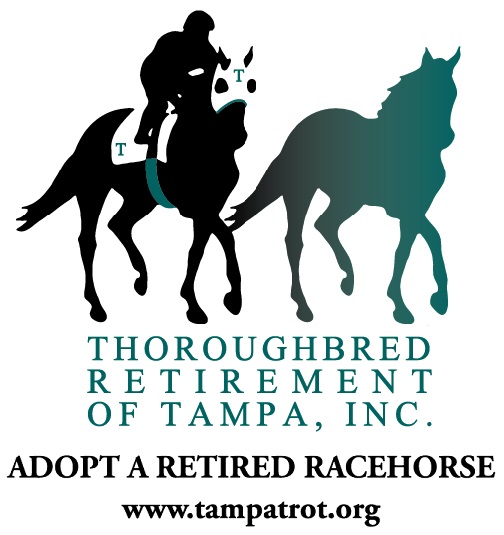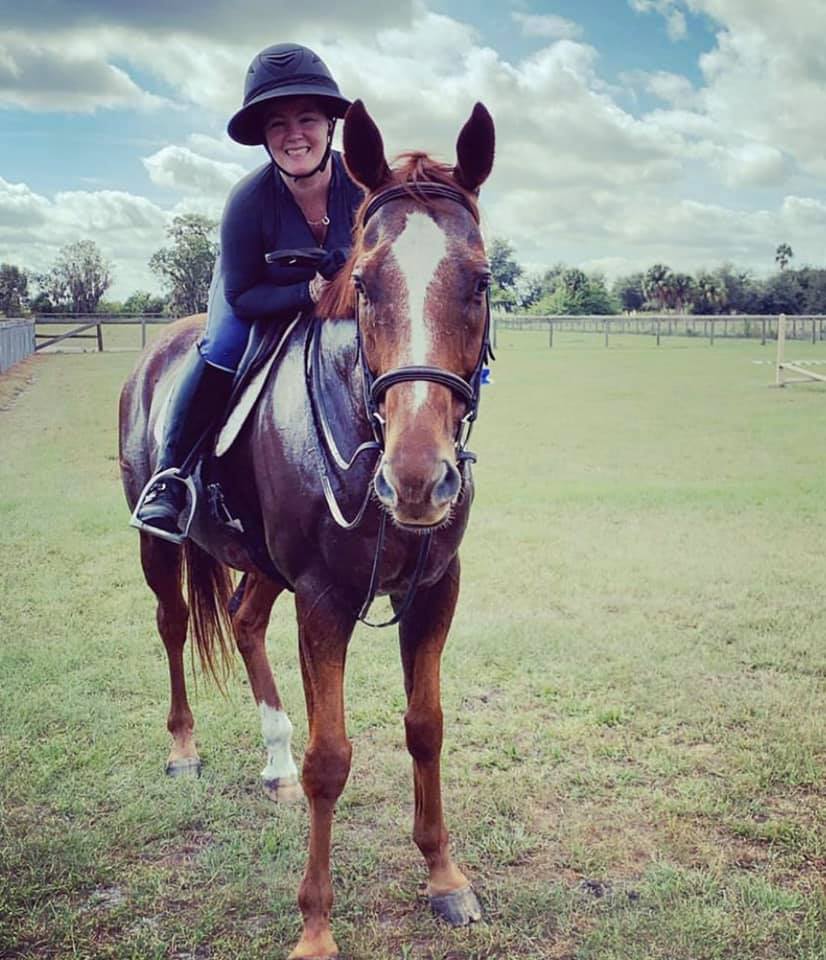
Q&A with TROT
What does TROT stand for?
Commonly referred to as TROT, Thoroughbred Retirement of Tampa Inc is a Florida nonprofit organization and 501(c)(3) that specializes in Thoroughbred aftercare.
How did your program begin?
The organization started out as Thunder Bay Horse Rescue in September 2003. In 2009, the organization’s leadership changed. In May 2009, its legal name changed to what it is today. Since that time, TROT has taken in 58 thoroughbreds into its program and rehomed 46.
What makes TROT unique?
Unlike many OTTB groups, they don’t have their own facility. They currently board their horses at two separate locations. Four of the horses, lovingly called the Thoroughstangs, live as a herd on five acres with access to a pond. And right next door to that, their resident curmudgeon Pure Pulpit resides in a more traditional boarding setting, where he is in his stall during the day and turned out at night with the other boarded horses.
What happens when a horse is accepted into your program?
When a horse enters TROT’s program, its ownership is signed over to the organization. TROT then works with the former racing connections to complete the Sold As Retired From Racing form. That fully executed form is mailed to the Jockey Club along with the registration papers and four conformation photos. The Jockey Club logs this info into their database and returns the papers to TROT stamped RETIRED FROM RACING. Each horse is given time to just relax and be a horse. When the horse is ready to start training, it is continually evaluated and eventually becomes available for adoption.
What is the process for interested adopters?
People interested in adopting a retired racehorse complete an application. The team at TROT screens the potential adopter, facility, and references. Typically, they don’t adopt out to first time horse owners unless that person is working with a trainer. If the interested person meets their guidelines, TROT has the person meet the horse to see if it’s a good fit. Adopters sign a contract that includes reporting throughout the first year. (Many owners actually keep in contact with TROT for much longer.) The contract states that if they are going to change ownership of the horse, they have to let TROT know and share information on the new owner. The horse can come back to TROT, if needed.
How many horses do you currently have?
TROT has five horses. Four of those horses are non-ridable and available for adoption as pasture pets. The fifth, Pure Pulpit, broke his left pastern in the field a little over one year after retiring from racing. He was successfully rehabbed but cannot be ridden. Pure Pulpit also has flare ups of lymphangitis that require specialized care. He is the organization’s only permanent resident.
How does TROT receive funding?
TROT receives funding through a number of sources. These include individual donors, grants, and support from Tampa Bay Downs. They also receive donations via Amazon Smile, Good Search (which uses your online searches to earn money for nonprofits), iGive (stores participate and donate), eBay for charity, PayPal Giving Fund, Network for Good (Facebook fundraisers), Benevity, and company matches. TROT has monthly informational tables at Tampa Bay Downs during the live racing meet. They have a selection of branded items available for minimum donations at these events.
Do you have a story about a horse that we can share with our readers?

Veteran runner and fan favorite, El Grande Rojo, was retired to our program by his racing owners, Neil and Laura Barrish, the day after his final race in 2019, which also happened to be his 11th birthday. The Barrishes explored many options for his retirement and chose our organization based on our commitment to individualized care and passion to ensure the long-term care and safety of our program horses.
After a seven-year racing career that included 18 wins in 84 starts (and $442,813 in earnings), it took some time for Rojo to adjust to life after racing. He had plenty of other OTTBs at the boarding facility to help acclimate and welcome him to his new life away from the racing world he thrived in and was accustomed to. We also gave him as much time as he needed. When we finally restarted him, we discovered that he loved a routine and loved to work. He eventually turned into a foster failure as our equine care manager Summer adopted him. He loves kids and now helps teach the next generation of equestrians.
A little over a year after his adoption, he was diagnosed with EPM. Summer was devastated but was determined to get him healthy again. He was successfully treated (and will be monitored for the rest of his life). Now he’s back as a lesson horse and winning ribbons in the show ring doing everything from leadline classes with the tiny riders, as well as excelling in both the hunter and jumper ring with more experienced riders. Never ever underestimate those war horses! They have huge hearts and are worth their weight in gold.
If people want to help your program, what can they do?
As noted in the funding question above, there are many easy options for supporting TROT. Please scroll up to see how you can help. You can also visit their How You Can Help page on their website – https://www.tampatrot.org/how_you_can_help.html.
